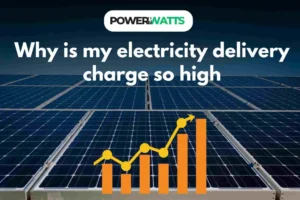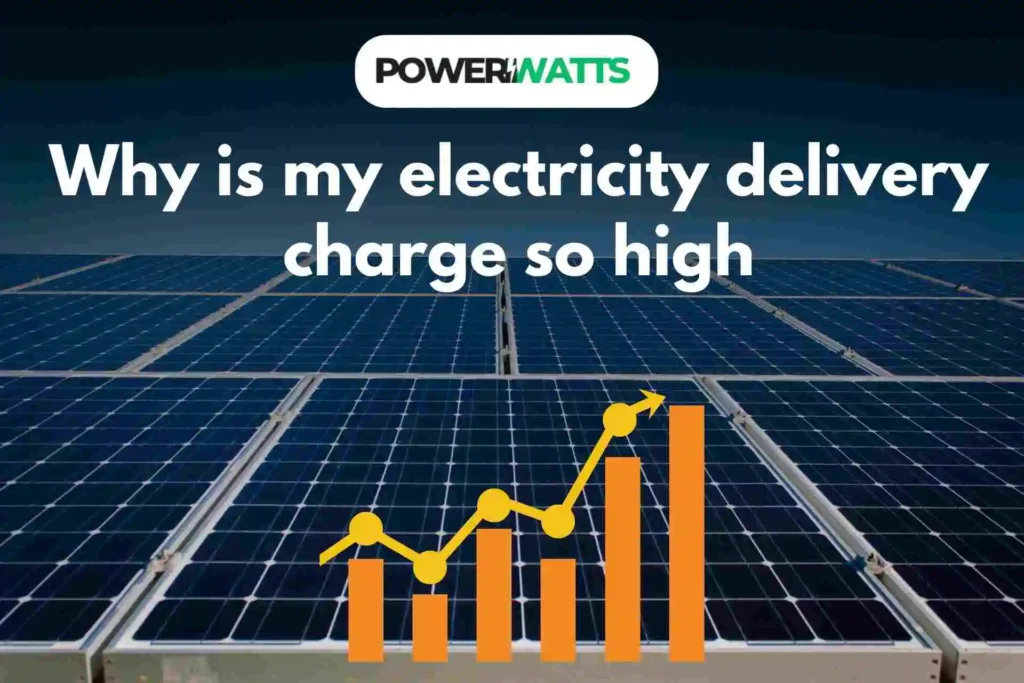Every time you open your monthly bill and worried about why is my electricity delivery charge so high? However, charge is not about the electricity you have consumed but something related to the “delivery charge.” It’s quite bewildering, especially when you have been working on how to reduce your energy consumption and find the delivery charge still high.
Knowing what is involved in this charge and why it can be high is helpful in managing your overall cost of electricity. In the discussion that follows, we outline the components of the electricity delivery charge, factors that determine the price, and what you can do to lower these charges.

What does an electricity delivery charge entail?
The delivery charge for electricity is the collection of the cost of carrying the electricity from the power plant to your house. This normally consists of breaking down into several elements, which include:
Transmission Charges:
It refers to the charges meant for maintaining and operating high-voltage transmission lines that carry electricity from the generation stations into substations.
Distribution Charges:
Distribution charges would entail the recovery of costs incurred in delivering electricity from local substations to your house through distribution lines at lower voltages. This includes all the infrastructure maintenance work involved in keeping the poles, wires, transformers, and other required equipment in good condition to ensure reliable electricity delivery.
Customer Service Charges
These are fixed charges that repair the cost of metering, billing, and providing customer service. Even if you use no electricity in a given month, you still may see this charge on your bill.
Capacity Charges:
Capacity Charges: These charges have to do with the demand placed on the electrical grid. As demand increases, so too must the infrastructure required to meet it, and the cost to maintain such capacity is then passed on to the consumer.
Why Is My Electricity Delivery Charge so High?
There could be several reasons why electricity delivery charges become exceedingly high. Let’s take a closer look at the most significant common causes.
Infrastructure Maintenance and Upgrades:
The upkeep and expansion cost for electrical grid infrastructure is very high. It falls to utility companies to ensure that the grid can be reliable and serve the needs of today’s electricity requirements. This infrastructural setup grows older with time; investing in the repair and replacement of items or parts thus increases with time, which in turn results in higher delivery charges.
Geographical Factors
Distance from your home to the power plant or substation: The farther away you live from a major substation, especially if this happens to be in some pretty rural country, the costlier it is to provide electricity to your location. Besides, areas with difficult terrain, like mountains or islands, may require more intricate infrastructure, hence increasing the costs.
Peak Demand Charges:
For example, on hot summer days, the electrical demand is a great deal more than on other days due to the cool comfort of air conditioners running at top speed. Of course, this raises the stress on the electrical grid, and utilities must have the capacity to meet such demand by firing up more expensive power plants or buying electricity from other utilities. These costs are then passed along in the way of higher capacity or peak demand charges.
Regulatory and Policy Costs:
Some areas charge additional fees to finance state or local renewable energy programs, energy efficiency programs, or any number of other regulatory needs. These can be a large component of your delivery fees, particularly if you reside in states with ambitious clean energy standards.
Fixed Costs Spread Across Fewer Customers
Utilities have fixed costs that must be accounted for regardless of consumption. Where populations or energy use is declining, fixed costs of maintaining the grid must be divided among fewer customers, raising delivery charges for remaining customers.

Can You Reduce Your Electricity Delivery Charges?
While certain elements of the delivery charge are beyond your control, there are things that you can do to possibly lower your overall bill:
Reduce peak usage:
Reducing the quantity of electricity you use during the peak demand period of the day is another method for reducing the amount of the electricity bill. Some utility companies, in that respect, have introduced time-of-use rates; this will charge you less when the demand for electricity is low. Do most energy-intensive activities, such as running the dishwasher or laundry, during the off-peak period.
Energy Efficiency Improvements:
Improvements to the energy efficiency of your home reduce the amount of electricity you need, which may lower your delivery charges. Examples are installing energy-efficient appliances, upgrading insulation and sealing drafts, and using LED lighting.
Take Advantage of Demand Response Programs:
Some utilities offer demand response programs that provide incentives for customers to reduce their electricity usage during peak demand periods on the grid. You will be contributing towards easing stress off the grid; plus, you get credits or reduced rates on your bill for participating in these programs.
Look into Options for Renewable Energy
If you happen to be in an area with a very high delivery charge, then putting solar panels on your rooftop or going into a community solar program can offset those particular costs. The payoff is that the initial investment could be considerable, but down the line, savings will be more logical and probable. Incentives may also be possible.
Conclusion
Delivery charges are complex and mostly misunderstood parts of your electricity bill. These charges also include a variety of base infrastructure costs to actually bring the power to your house, plus a whole raft of regulatory and environmental fees.
While many of the above costs are fixed and outside of your direct control, there are specific ways to optimize the overall bill through energy efficiency measures, peak demand reduction, and renewable energy options. But if you know what drives these charges, you’ll be able to make more informed decisions about how you can reduce your electricity cost and contribute to the development of a more efficient and sustainable energy system.
Get a Quote In case you are interested in integrating an inverter with a solar charger into your power system, do not hesitate to contact us today for your custom quote.


